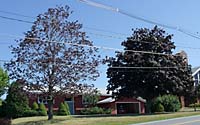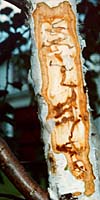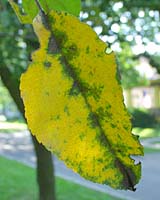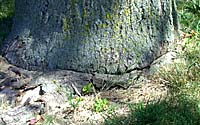Terry L. Ettinger Horticulture Consulting Services
Meeting The Needs Of Today With A Vision For The Future
Landscape and
Lawn Management Services
Pest Identification and Management
 Most
of the plants in your landscape are probably doing well - some may
even be doing too well! Therefore, it can be very
frustrating and cause for concern when a plant fails to thrive, or
has been doing well and suddenly begins to decline - like the large
`Crimson King' Norway maple tree in the photo at right.
Most
of the plants in your landscape are probably doing well - some may
even be doing too well! Therefore, it can be very
frustrating and cause for concern when a plant fails to thrive, or
has been doing well and suddenly begins to decline - like the large
`Crimson King' Norway maple tree in the photo at right.
 Often,
when we see a plant start to decline our first reaction is to assume
that some sort of insect or disease is involved.
Often,
when we see a plant start to decline our first reaction is to assume
that some sort of insect or disease is involved.
 That
certainly can be the case, for example, when an infestation of Bronze Birch Borer
larvae gradually girdle the trunk of European white and Paperbark birch trees
(photo at left). On the other hand, while dramatic - and frustrating
- severe apple scab infestations on crabapple (photo at right) do
not harm infected plants and may not even occur in years having
warm, dry spring weather.
That
certainly can be the case, for example, when an infestation of Bronze Birch Borer
larvae gradually girdle the trunk of European white and Paperbark birch trees
(photo at left). On the other hand, while dramatic - and frustrating
- severe apple scab infestations on crabapple (photo at right) do
not harm infected plants and may not even occur in years having
warm, dry spring weather.
I can help you figure out why plants in your landscape are not growing as vigorously as they should - and recommend appropriate treatments if warranted.
 By the way, the decline affecting the Norway maple
tree pictured above wasn't caused by an insect or disease. Rather,
the tree was suffering from a common abiotic (non-living) affliction of Norway maple and littleleaf linden trees
called "girdling roots" (photo at right).
Therefore, no amount of pesticides - or fertilizer, for that matter
- could have saved this tree!
By the way, the decline affecting the Norway maple
tree pictured above wasn't caused by an insect or disease. Rather,
the tree was suffering from a common abiotic (non-living) affliction of Norway maple and littleleaf linden trees
called "girdling roots" (photo at right).
Therefore, no amount of pesticides - or fertilizer, for that matter
- could have saved this tree!